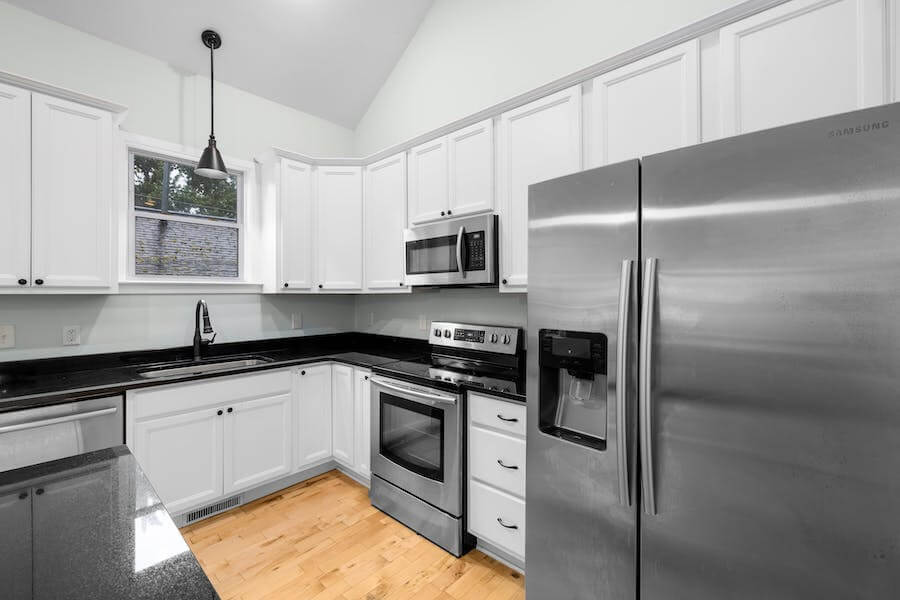The defrost cycle is an indispensable part of the freezer. It prevents the buildup of frost and ice on the evaporator coil, which can reduce the appliance’s efficiency. Depending on the brand or model, the freezer either has a manual defrost or an auto defrost mode.

In some cases, the freezer has both. For your freezer to continue to offer reliable refrigeration for your stored items, defrosting is essential.
Reasons Why your Freezer Defrost isn’t Working and What to do
When a freezer defrost system malfunctions, two frequent issues could arise. The freezer or refrigerator wouldn’t defrost, and even if the freezer is cold, the freezer is not. Having issues with your freezer defrost can be caused by various factors.
The solutions at your disposal also vary depending on the specific problem you’re facing. Here are some common causes and their respective answers:
1. Frost Buildup on Evaporator Coils
If the evaporator coils inside the freezer are covered in frost, it can disrupt the defrost cycle. Usually, the evaporator coils in the freezer absorb heat from the inside. This is what keeps the contents cold. As they do this, moisture in the air within the freezer can condense and freeze on the coils, forming a layer of frost.
Solution:
- Defrost the coils by turning off the freezer and letting the ice melt. Then, you can clean the coils.
- Check the defrost heater, thermostat, or the timer for any malfunctions.
2. The Defrost Heater is Faulty
The defrost heater is an essential component in the freezer’s automatic defrost system. Its primary function is to heat the evaporator coils regularly to melt any accumulated frost or ice. If the defrost heater is not working correctly, it won’t generate the necessary heat to defrost the coils.
This can lead to a buildup of frost and ice on the waves. In turn, this can reduce the freezer’s cooling efficiency and airflow. Ultimately, it causes temperature fluctuations and prematurely thaws your frozen items.
Solution:
- To troubleshoot the defrost heater, test it for continuity with a multimeter. Then, you can replace it if necessary.
- Ensure the refrigerator temperature is below 46℃ (115°F) for accurate testing. Place the leads on the wires connected to the control board that is part of the defrost heater circuit. If the course has continuity, the multimeter should read between 10 to 150 ohms. This indicates that the defrost heater is functioning correctly.
- Replacing the faulty defrost heater with a new one ensures the automatic defrost cycle functions correctly.
3. Defective Defrost Thermostat
The defrost thermostat may not be detecting the temperature correctly. This prevents the defrost cycle from starting. The defrost thermostat is temperature-sensitive, located on or near the evaporator coils inside the freezer.
Mainly, its purpose is to monitor the temperature of the evaporator coils. If the thermostat fails to detect the drop in temperature, it won’t initiate the defrost cycle. If the frost has built up on the waves, this can result in excessive frost accumulation,
Solution:
- Test the thermostat for continuity, and if it’s faulty, then you need to replace it. No continuity means that the electric path of the thermostat is defective.
- Before you test the defrost thermostat, make sure the refrigerator is unplugged. Also, disconnect the cables connected to the thermostat. This is to avoid any incidence of an electrical shock hazard.
4. Issues with the Defrost Timer
The defrost cycle in the freezer is regulated by either a mechanical defrost timer. Their proper functioning is essential for the defrost cycle to operate as needed. A defrost timer is an automatic device that keeps track of time.
It is set to initiate the defrost cycle at regular intervals, typically every 6 to 12 hours. But this depends on the design of the appliance. Most timers are in defrost mode for 30 minutes. When the timer reaches the pre-set defrost interval, it triggers the defrost cycle.
Solutions:
- You might have to replace your defrost timer, but before doing this, troubleshoot the timer. This will let you know if the timer is indeed the problem. You must, however, understand how the defrost timer operates before you can test it.

5. Problem with the Control Board
Problems in the control board can also lead to defrost cycle failures. Some modern freezers have an electronic control board that manages functions like the defrost cycle. The control board comprises sensors that monitor the temperature and frost buildup on the evaporator coil.
When the sensors detect that the ring needs defrosting, the control board initiates the defrost cycle. However, If the electronic control board fails, it can disrupt the freezer’s ability to detect a defrost cycle accurately.
Solution:
- Check and replace the control board if they are malfunctioning. An issue with the control board is more complex to replace. You need a professional to install a new control board. You must ensure that the replacement board is compatible with the model of your freezer.
- Regular maintenance and inspections can help prevent these problems. You’ll be able to identify issues before they get out of hand.
6. The Door Seals is Left Open
When the freezer door is left open, warm and humid air encircling the environment enters. This warm air carries moisture in the form of water vapor. Leaky or damaged door seals can let in warm, moist air, causing frost to form.
Solution
- If the door seals are faulty, replace them to maintain a proper seal.
- Make sure to close the freezer door securely each time you use it. Even a tiny gap in the seal can cause warm air infiltration and frost buildup.
- Examine the door gasket for any visible damage, wear, or tear. If the seal is damaged, it must be replaced to ensure it is sealed properly. Typically, you should be able to purchase a replacement from the freezer’s manufacturer or authorized dealers.
7. Power Supply Issues
Fluctuating power supply or electrical problems can also affect the defrost cycle. These fluctuations could disrupt the regular operation of the freezer, even momentarily. For example, when the power supply briefly drops or surges, it can interrupt the defrost cycle.
This could cause it to either start prematurely or not start when it should. Otherwise, there might be electrical problems within the freezer itself. It could be damaged wiring, faulty connections, or malfunctioning electrical components. These can disrupt the operation of the defrost cycle.

Solution:
- Ensure there’s a stable power source for the freezer, and check for any electrical issues.
- Install a surge protector or voltage stabilizer. This would protect the freezer from sudden power surges.
- If there’s any issue within your home’s wiring, it is essential to address it. These can contribute to power supply problems.
These are the most common issues to look out for if your freezer defrost isn’t working. No matter which parts of these components fail, the symptoms are usually the same. In some cases, instead of determining which of the three is malfunctioning, the technician would replace all three.
If you’re unable to handle DIY repairs, it’s advisable to consult a professional appliance technician. They can diagnose and fix the specific issue with your freezer’s defrost system.
